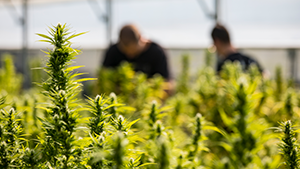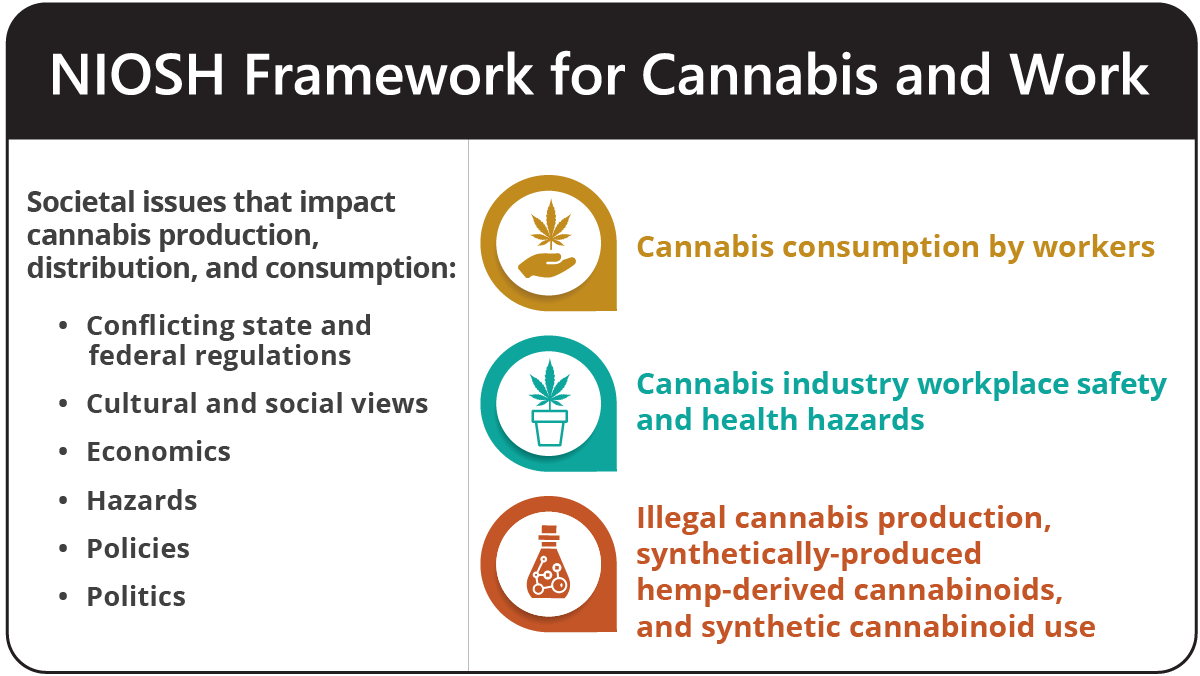At a glance
- Cannabis industry exposures and hazards can be chemical, biological, or related to safety and well-being.
- Employers and workers can take steps to create a safe and healthy workplace

Overview
Cannabis remains illegal under U.S. federal law. However, many states have passed laws to allow the growth and use of cannabis for medical or adult (21+ years of age) use purposes. This has caused the number of workers in the cannabis industry to grow substantially.
Activities in the cannabis production and distribution industry include:
- growing cannabis plants indoors and outdoors,
- processing plants and manufacturing products for consumption,
- selling products in retail shops and dispensaries, and
- transporting products for sale and distribution.
Some worksites may specialize only in certain operations such as cultivation and harvesting. They send products to other facilities for further processing or retail. Other worksites in the industry may include all aspects of the process.
As laws, regulations, and attitudes change related to producing and selling cannabis, workers' health, safety, and well-being must also be addressed. Recognizing these rapidly occurring changes, NIOSH seeks to:
- Better understand cannabis and work-related issues
- Provide advice on workplace policies, programs, and practices.
Workplace exposures
Potential workplace exposures and hazards may include:
- Chemical exposures
- carbon dioxide
- ozone
- pesticides
- volatile organic compounds
- carbon dioxide
- Biological exposures
- allergenic proteins
- endotoxins
- microbials
- organic particulate matter
- allergenic proteins
- Ergonomic and physical hazards
- heat stress
- noise
- ultraviolet light
- heat stress
- Safety hazards
- cuts and lacerations
- electrical safety issues
- fire and explosion hazards
- slips/trips/falls
- working at heights
- cuts and lacerations
- Impacts on worker mental health and well-being
- communication issues
- work organization
- workplace violence
- communication issues
Framework
NIOSH has developed a framework for addressing workers' safety, health, and well-being related to cannabis, in light of rapidly changing laws and public attitudes, and includes guiding questions for future research. Learn more about these needs in Cannabis and work: need for more research.

Guiding questions
The following are some guiding questions for the cannabis industry:
- What health effects do cannabis workers experience and what are the extent of such effects in this workforce?
- How can we best protect the health and safety of workers in this industry?
- How can we best protect the health and safety of firefighters and emergency response workers from hazards of clandestine cannabis operations?
Best practices
What employers can do
Federal and state laws require employers in all industries to provide a workplace free from hazards likely to cause serious harm to employees. In previous evaluations of hazards at cannabis cultivation and processing facilities, NIOSH provided specific recommendations based on the hierarchy of controls.
Actions for employers to consider for preventing workplace injuries and illness include:
Use elimination to physically remove the hazard. If eliminating the hazard is not feasible, use substitution to replace with something less hazardous.
- Develop a safety plan to identify, evaluate, and remove or reduce hazards.
- Use prevention through design when developing equipment.
- Get rid of toxic chemical or use less toxic chemicals.
Use engineering controls to keep people from the hazard.
- Design tasks, workspaces, and tools to reduce hazards.
- Use and evaluate ventilation controls to control airborne exposures.
Use administrative controls to change the way people work.
- Administer training to workers on identified health and safety hazards.
- Seek workers' input about work policies.
- Assess their impact on worker wellbeing.
- Offer health evaluations or screenings to new and existing employees.
- Implement cleaning procedures to limit exposure.
Provide and train workers on the use of appropriate personal protective equipment (PPE) to protect them from the hazard.
What workers can do
- Follow all health and safety procedures, and cleaning guidelines.
- Monitor health symptoms following work activities.
- Seek medical care for symptoms potentially related to work activities.
- Properly use PPE provided in the workplace.
Notify your employer if you believe you have developed symptoms associated with workplace activities or cannabis exposure. Symptoms may include breathing problems, skin allergies, or musculoskeletal injuries.
Resources
NIOSH & CDC
Reports
Blogs and Videos
Cannabis on the NIOSH Science Blog
Cannabis and Workers' Compensation: Now What? (webinar)
Health Hazard Evaluations
NIOSH conducts Health Hazard Evaluations (HHEs) to learn whether health hazards to workers are present at a workplace and recommends ways to reduce hazards and prevent work-related illness and injury. For a comprehensive listing of related HHE reports search cannabis in the HHE Database.
Other resources
NIOSH/NIOSH funded research: See the NIOSHTIC-2 database search results on cannabis worker safety and health risks related to cannabis production, distribution, and consumption. NIOSHTIC-2 is a database of occupational safety and health publications funded in whole or in part by NIOSH.
Pesticides and cannabis: The federal government has not evaluated or registered any pesticides for cannabis. However, some states provide guidance for selecting and properly using pesticides for cannabis. Examples include those from Colorado, California, and Washington State. Pesticide worker protection requirements, apply to all agricultural commodities, including cannabis.
